Dr. Howard Fourth Graders Learn Engineering, Problem-Solving, While Building Solar Cars
November 6, 2018
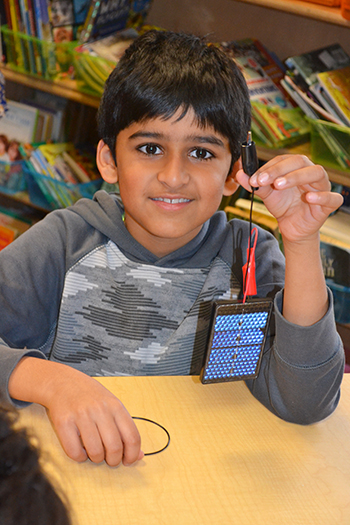
A Dr. Howard School student showing the solar cell he will use to power his solar car.
Design. Build. Test. Tweak. Test again. These are the engineering design process steps three Illinois Engineering seniors, Peter Sokalski, George Popovic, and Cameron Harris, have been underscoring during their Fall 2018 visits to Dr. Howard School in Champaign. Their goal: introduce Jennifer Simmons’ fourth grade students to engineering via a fun solar car project. In addition to the kids learning about engineering and adding skills related to construction and problem solving, the three visitors, along with Ms. Simmons, also hoped that the students would grow personally in regards to their perseverance, communication skills. and self-confidence. Plus, their long-range goal was to show the kids that they too have what it takes to become engineers when it’s time to think about careers.
Peter Sokalski, a senior in Mechanical Science and Engineering (MechSE) at Illinois who intends to begin working on his PH.D next fall, initially contacted Jennifer Simmons and met with her to discuss his idea to provide an engineering activity for her students. Along with help from Joe Muskin, MechSE Educational Outreach coordinator and Education Coordinator for the NSF-funded POETS (Power Optimization for Electro-Thermal Systems) Engineering Research Center, the two decided that her students should tackle building a solar car.. During the project, the kids not only learned the basics of how a solar cell and a car work, but a lot about the engineering design process too. Plus, building solar-powered cars was the ultimate hands-on project, and allowed the students to learn a lot about construction. For instance they learned how to work with nuts and bolts and whether to apply force close or far away and how that changes.
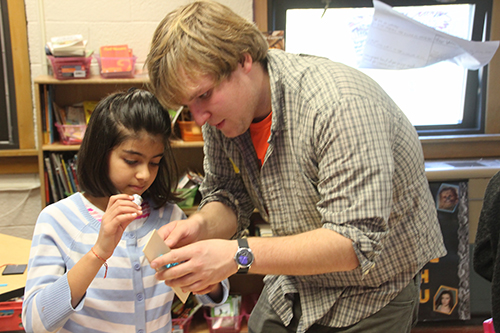
Peter Sokalski (right) helping a fourth grader build her solar car. (Image courtesy of Joe Muskin.)
According to Muskin, the solar cars curriculum was developed as a part of POETS’ RET program. During the RET’s multi-year effort, a team of four local science teachers, Uni High’s David Bergandine and Sharlene Denos, Next Generation School’s Bryant Fritz, and Centennial’s Jay Hooper, worked to create a multi-week curriculum unit related to power, heat, and power density aligned with Illinois’ Next Generation Science Standards (NGSS).
The students constructed their cars using wood, foam, 3D-printed wheels, and rubber-band pulleys, to name a few. They began by simply playing around with the various materials, but quickly discovered which materials were the best to use in building their cars. To get the thing to “run” via solar power, they hooked up a small solar panel to a DC motor then tested it beneath a lightbulb that generated artificial “sunlight.”
In addition to the solar car projects, the engineering students also plan to teach the students a bit about emerging technologies related to the research the three of them are currently doing. These include new material science and interfacial behaviors, as well as a quick lesson about wave-phenomenon.
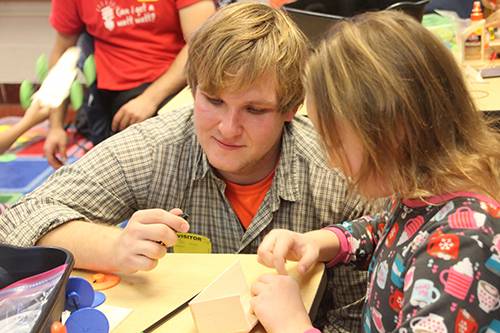
Peter Sokalski (left) helping a fourth grader build her solar car. (Image courtesy of Joe Muskin.)
“Wireless technology pretty much dominates our lives,” Sokalski admits, “whereas most people don't really know how optic-fibers work or how wi-fi works. So we hope to introduce these topics to the kids at a very basic level as well.”
Related hands-on activities they’ll be doing with the students regarding these topics include demonstrating the ability to manipulate the wet-ability of materials by making a roller-coaster of aluminum foil, sticks, and water. Finally, they hope to show some wave behaviors, like internal refraction of light using water.
Sokalski, who currently splits his time between working on an optomechanical sensor for Dr. Guarav Bahl, and projects relating to condensation fundamentals/application for Dr. Nenad Miljkovic, says his goal in being involved in the Dr. Howard outreach was to diversify his presence on campus a little bit. “I’ve worked plenty with students on campus, but have yet to extend myself to the local community, and working with these kids is the best way to do that!”
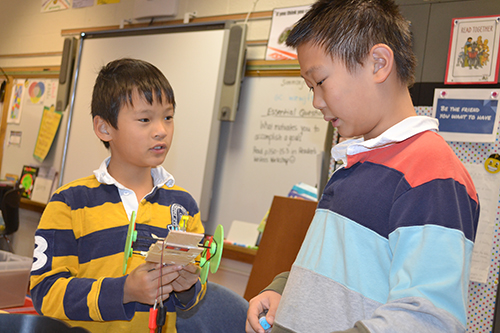
Two Dr. Howard students discuss their solar car design.
Plus, he finds it fun to see if he can explain the science and work he does at a very basic level. “Being in research is 50% performing research and 50% communicating that research,” he acknowledges, and says that “practicing with kids is a good way to test the latter half of that!”
According to Sokalski, one important aspect of engineering he wanted the students to gain insight on during the activity was the engineering design process: “The methodology of testing-iterating-improving is being emphasized with the solar cars,” he explains.

A Dr. Howard school student works on building her solar car.
In fact, as part of the fourth grade students learning this process, he claims that their designs needed to fail the first time ‘round, so the students would have some challenges to overcome.
“It is important for bits and pieces of the car building process to not work,” he admits, “so the students can critically think and improve their design. I believe this is the basis of what we learn here at school.”
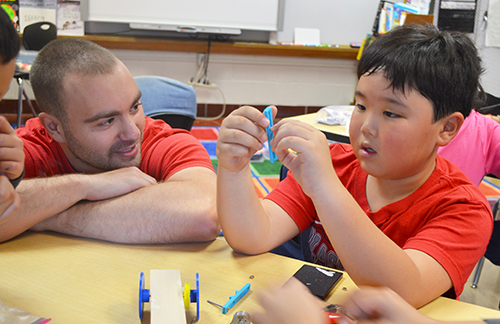
George Popovic (left) helping a student build his solar car.
Also helping out (and getting in on the fun) was George Popovic, who’s due to graduate with his Bachelor’s degree in December then begin working on a Master’s in January, and hopes to continue on to a PHD after that. Popovic, who works with thermo-fluid sciences and condensation, says he got involved in the outreach at Dr. Howard School in order to pique the kids’ interest in engineering. “I want to demonstrate to the kids all the cool stuff that engineers get to do on a daily basis and hopefully motivate the kids that are already interested in becoming engineers to follow their dreams,” Popovic explains.
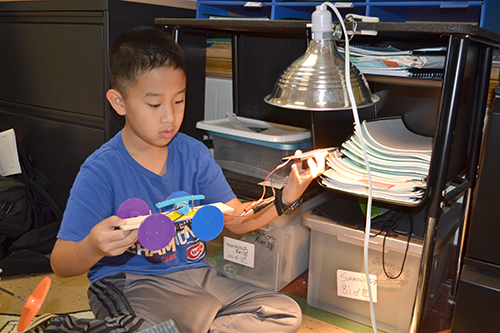
A Dr. Howard student tests out his solar car.
He adds that, in addition to all of the hands-on experience, the fourth graders also have to “employ a lot of creative thinking to build a decently complex project.” He indicates that their strategy has been a rather laissez faire approach: to “kind of leave them alone and make them talk through their ideas and figure out the steps by themselves.”
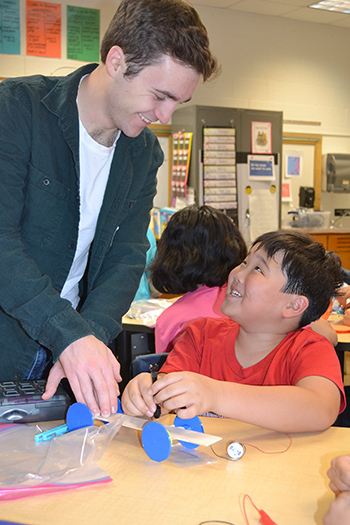
Cameron Harris (left) helps a student build his solar car.
He adds the students also are exposed to teamwork. For example, tools are limited, plus: “They all work in pairs of two or three, so they have to make collaborative decisions on how to tackle tasks.”
The third Illinois student on the project was Physics Engineering student Cameron Harris, an undergraduate research assistant in MechSE Professor Guarav Bahl’s research group. He shares why he got involved with the outreach.
“Mainly because I’m really a proponent of the idea of increasing scientific literacy just in the community in general. Being in the College of Engineering at UIUC is really great, but it’s also really isolated in our thinking, and not everyone is familiar with the scientific method, and just science in general. We thought it’d be a neat idea to sort of cultivate that in the younger generation, getting other people familiar with science, and reach out to the community.”
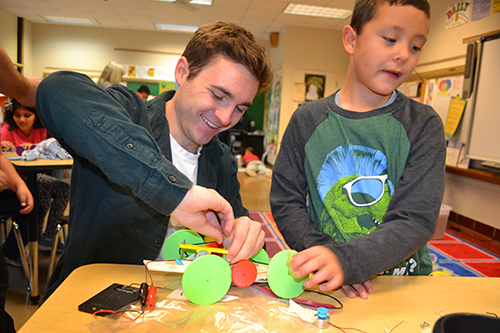
Cameron Harris helps a fourth grader with his solar car.
Has Harris seen any engineers in the class? “Oh, absolutely!” he acknowledges. “A lot of these kids are smarter than I am! It’s been really humbling to work with fourth graders who know more than me!”
In regards to the benefit of bringing college students into an elementary classroom setting, Harris explains, “I suppose we might be young enough to still be able to relate and interact with the kids on a personal level, and at the same time, we’ve had a lot more experience with this stuff. And I think it’s just sort of the right age group to really interact well.”

Jennifer Simmons chats with students about the solar car they built.
Dr. Howard 4th grade teacher Jennifer Simmons would agree about the many benefits of having Illinois engineering students come into her classroom. For one, to share their passion for STEM. “If students are volunteering to help, they have a contagious energy and enthusiasm for learning,” she explains. She adds that another perk of the project is that there are three more adults in the classroom to help, since STEM projects generate lots of questions and a need for one-on-one help.
Simmons reports being thrilled by Peter's suggestion that her students build solar cars, because their current unit in science is on energy and waves. “They are learning the forms of energy and how it is transferred, both through reading and exploration through the cars. They will remember this forever!” she claims.
In addition to the engineering skills her students have been gaining through the project, Simmons believes that the project has been impacting them in a number of other ways that will apply to all areas of their lives.
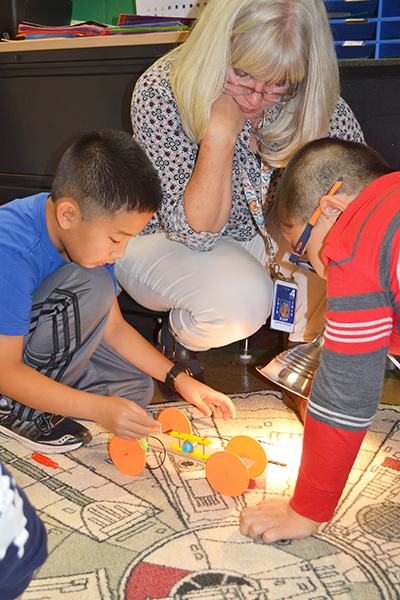
Fourth grade teacher Jennifer Simmons looks on as two of her students test their solar car.
“I hope that designing, building, and redesigning the cars help them with their problem-solving skills and perseverance. I also see them gaining confidence as they figure things out.” She also believes that their communication skills have been improving as they learn to provide explanations and ask questions. “Lastly, the hands-on experience with energy and solar power is priceless,” she continues.
Simmons adds that the project works because the guys who are leading the project “have obviously done this before.” She claims that: “They are organized and effective with the materials, yet they don't give away the answers, since they want the students to be creative and problem-solve.” Adding that they are all also friendly and patient, she wishes she had several more engineering students to work with her other 4th grade classes. “I feel fortunate that I was available to start when they contacted me,” she says.
Story by Elizabeth Innes, Communications Specialist I-STEM Education Initiative. Photographs by Elizabeth Innes, except where noted.
More: Engineering, K-6 Outreach, POETS, 2018
 George Popovic (center) helps two students work on their solar car.
George Popovic (center) helps two students work on their solar car.












.jpg)
















